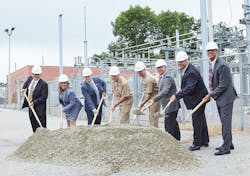Construction Begins on 7.4-MW Fuel Cell Park at Naval Submarine Base New London
Connecticut Municipal Electric Energy Cooperative (CMEEC), the US Navy and FuelCell Energy are setting the keystone of a microgrid that will enhance energy services at Naval Submarine Base New London (SUBASE) in Groton, Connecticut.
The project partners recently broke ground for a 7.4 MW fuel cell park on unused Navy land at SUBASE. The project’s completion will mark another milestone in SUBASE’s plans to deploy a microgrid capable of reducing energy consumption, costs and environmental impacts while at the same time enhancing energy reliability and resiliency at the base, home to the US fleet of nuclear-powered submarines and submariners.
Danbury, Conn.-based FuelCell Energy will build, own and operate the fuel cell park, delivering electricity to wholesale supplier CMEEC under a 20-year power purchase agreement (PPA). CMEEC’s customer’s include Groton Utilities, which in turn serves SUBASE.
Enhancing energy reliability and energy resilience
The project operates under the Navy’s Enhanced Use Leasing program, an effort to leverage the value of underutilized and under performing assets via the private sector.
The fuel cell park will enhance energy services for SUBASE, Groton Utilities and CMEEC’s utility customers in line with Connecticut state goals, as well as those of the Navy’s Enhanced Use Leasing program and its broader-based drive to reduce energy consumption and reliance on foreign sources of oil by increasing use of alternative energy.
SUBASE and the Navy are not directly contracting for the electricity the fuel cell park produces. SUBASE will remain connected to Groton Utilities’ power grid and the Navy will continue to pay for electricity as per the current tariff, CMEEC CEO Drew Rankin told Microgrid Knowledge.
In lieu of land lease payments for making use of the fuel-cell park site, CMEEC will make an in-kind payment to the Navy in support of SUBASE’s microgrid, which is moving through its planning stages.
The Navy has recently invested more than $50 million to improve electrical and steam generation and distribution systems at SUBASE. Part and parcel of that, some $12 million in energy conservation projects have been carried out at the base in the past five years.
A microgrid in the making
The fuel cell will be supplemented by a 5-MW natural gas combustion turbine and additional emergency generators. Ultimately, these will be integrated into a microgrid capable of actively managing supply and demand throughout SUBASE both in parallel to the utility grid and in autonomous, island mode, Rankin explained.
“SUBASE already has a microgrid design to achieve the intelligent microgrid throughout the base, which will be constructed in the near future. CMEEC is to serve as the project manager for the final design, construction and commissioning of the microgrid,” Rankin said.
A tax-exempt, public power agency, CMEEC is not able to capitalize directly on Connecticut’s fuel-cell investment tax credit (ITC), one of the few instituted across the US. CMEEC is able to monetize the ITC in part by incorporating some of the tax credit’s value into, and thus lowering the cost of energy, in the PPA with FuelCell Energy, Rankin explained. FuelCell Energy originally announced the deal in May 2017.
The SUBASE fuel-cell park will enable CMEEC to avoid infrastructure costs, the projected net benefits of which will accrue to CMEEC and ultimately its owners and customers, according to Rankin.
“The PPA is not directly tied to the SUBASE’s needs, and contains no terms or conditions relative to their electric needs. CMEEC and the Navy sized the installed capacity (function of critical load levels) as the first large anchor to the planned (in development) SUBASE microgrid,” Rankin said. “This will act as a direct source of power should the local distribution system or bulk power system fail.”
Broad-based benefits
As a result, CMEEC will be able to make productive, day-to-day use of the fuel cell to enhance its ability to serve customer loads system-wide. The fuel-cell facility will switch to island-mode operations and continue to provide power to meet SUBASE’s critical loads in the event of a utility grid outage, however.
The projected, net benefit of the fuel cell park will vary based on the actual future cost of natural gas, Rankin said. “The net present value ranges from $16 million to $35 million based on a $2 per MMBtu to $8 per MMBtu range for a NYMEX gas prices stress case. Of course, pro formas are a projection and subject to 20 years of market conditions,” Rankin said.
In addition, the fuel cell will avoid nine tons of nitrogen-oxide emissions, 2.46 tons of sulfur-oxide emissions, and 4,926 tons of carbon dioxide emissions per year. It will also reduce the amount of water used for power generation tremendously as compared to the typical thermal power plant, Rankin said.
Looking forward, CMEEC, the Navy and FuelCell Energy are in the process of finalizing the next steps to be taken regarding construction of SUBASE’s microgrid. CMEEC expects to be able to publish these plans in the next several months, Rankin said.
Track news about fuel cell microgrid projects. Subscribe to the free Microgrid Knowledge newsletter.
